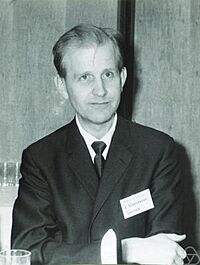Lars Hörmander facts for kids
Quick facts for kids
Lars Hörmander
|
|
|---|---|

Hörmander in 1969
|
|
| Born |
Lars Valter Hörmander
24 January 1931 |
| Died | 25 November 2012 (aged 81) Lund, Sweden
|
| Nationality | Swedish |
| Alma mater | Lund University |
| Known for | Theory of linear partial differential equations, hyperbolic partial differential operators, the development of pseudo-differential operators and Fourier integral operators as fundamental tools |
| Awards | Leroy P. Steele Prize (2006) Wolf Prize (1988) Fields Medal (1962) |
| Scientific career | |
| Fields | Mathematics |
| Institutions | Stockholm University Stanford University Institute for Advanced Study Lund University |
| Thesis | On the theory of general partial differential operators (1955) |
| Doctoral advisor | Marcel Riesz Lars Gårding |
| Doctoral students | Germund Dahlquist Nils Dencker |
Lars Valter Hörmander (born January 24, 1931 – died November 25, 2012) was a famous Swedish mathematician. Many people called him the most important person in the modern study of linear partial differential equations. These are special math problems that describe how things change.
Lars Hörmander won several big awards for his work. He received the Fields Medal in 1962, which is like the Nobel Prize for mathematics. He also won the Wolf Prize in 1988. In 2006, he got the Steele Prize for his four-book series. These books, called Analysis of Linear Partial Differential Operators, are very important for anyone studying this type of math.
Hörmander earned his Ph.D. (a high-level university degree) in 1955 from Lund University in Sweden. He worked at several universities, including Stockholm University, Stanford University in the U.S., and the Institute for Advanced Study in Princeton, New Jersey. He returned to Lund University in 1968 and taught there until he retired in 1996.
Contents
Biography
Early Life and School
Lars Hörmander was born in Mjällby, a small village in southern Sweden. His father was a teacher. Lars went to secondary school and high school in nearby towns. He graduated from high school in Lund in 1948.
When he was in high school, the principal tried a new way of learning. Students spent less time in class, only three hours a day. This gave Lars a lot of freedom to study on his own. He really liked this way of learning. His math teacher, who was also a professor at Lund University, encouraged him to study advanced math.
University Studies
After high school, Lars went to Lund University. He earned his Master's degree in 1950. Then, he started his Ph.D. studies with Professor Marcel Riesz. Lars first tried to research other math topics. These attempts helped him prepare for his later work.
When Professor Riesz retired, Professor Lars Gårding became his new advisor. Professor Gårding was an expert in partial differential equations. This led Lars Hörmander to focus on this important area of mathematics.
Lars took a break for military service from 1953 to 1954. But even during this time, he could continue his studies. He finished his Ph.D. thesis in 1955. His thesis was about "general partial differential operators." This work was inspired by other mathematicians and new methods for solving math problems.
Fields Medal and Time in the U.S.
After finishing his Ph.D., Hörmander applied for a professor job in Stockholm. While he waited, he traveled to the United States. He visited several universities, including the University of Chicago and Stanford University. He learned a lot about partial differential equations during these visits.
His former advisor, Lars Gårding, said that Hörmander made the "deepest and most significant" contributions to the study of linear differential operators. Because of his amazing work, Lars Hörmander won the Fields Medal in 1962. This is one of the highest honors a mathematician can receive.
In 1963, Hörmander became a part-time professor at Stanford. Soon after, he was offered a full-time job at the Institute for Advanced Study in Princeton, New Jersey. This institute is a famous place where top scientists do research. He decided to take the job because it allowed him to focus only on research. He worked very hard there for two years. However, he felt the environment was too demanding. In 1967, he decided to return to Lund. He later said that his best work at the institute was done in his last year there.
Later Years and Awards
After 1968, Hörmander mostly stayed at Lund University as a professor. But he still visited the United States many times over the next 20 years. He visited the Courant Institute and the Institute for Advanced Study again. He also visited Stanford and the University of California, San Diego.
For a short time, from 1984 to 1986, he was the director of the Mittag-Leffler Institute in Stockholm. He only took the job for two years because he thought the administrative tasks would not suit him. He found that his feeling was right. He also served as vice president of the International Mathematical Union from 1987 to 1990.
Hörmander retired from Lund University in January 1996. In 2006, he received the Steele Prize from the American Mathematical Society. This award honored his important math books.
He became a member of the Royal Swedish Academy of Sciences in 1968. In 1970, he gave a major speech at the International Congress of Mathematicians. He received the 1988 Wolf Prize for his "fundamental work in modern analysis." This included his use of special tools like pseudo differential and Fourier integral operators to solve math problems.
In 2012, he was chosen as a fellow of the American Mathematical Society. Sadly, he passed away on November 25, 2012, before the list of fellows was officially announced.
See also
- Hörmander's condition
- Hörmander's theorem
- Oscillatory integral operator

